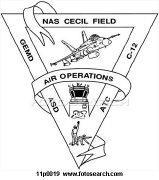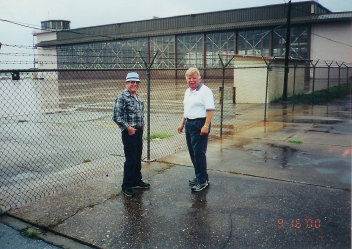
in Jacksonville, Florida. NAAS Cecil Field became the official Home Port Assignment of VA-106 on 18 September 1950 and
with an exception of a short period from Oct 1952 to Dec 1954 (where the squadron was Home Ported at NAS Jacksonville),
remained our Home Port until the squadron was disestablished in 1969.
Covering some 30,000 acres of land, NAS Cecil Field was the largest Military base in the Jacksonville area and consisted of four separate facilities; NAS Cecil Field Complex, Outlying Field (OLF) Whitehouse, Yellow Water Weapons Department and the Pinecastle Electronic Warfare Target Area / Warfare Range.
Shortly before the United States entered into World War II, a 2600-acre tract of land was purchased in Western Duval County in Northern Florida and construction of Cecil Field began. Construction of the base had just started when the attack on Pearl Harbor took place in June 1941 and was fully completed in late 1942. NAS Cecil Field was named in honor of Commander Henry Barton Cecil who died in 1933.
Shortly after completion, several VF (Fighter Squadrons) and VSB (Navy Scout Bombing Squadrons) of Advanced
Carrier Group, Atlantic arrived to commence replacement pilot combat training and Cecil Field was commissioned as a U.S. Naval Auxiliary
Air Station (NAAS) in February 1943. In March 1943, the fighter training unit moved to nearby NAAS Lee Field in Green Cove Springs,
Florida and NAAS Cecil Field became the principal war-at-sea and dive-bombing training center for the U.S. Navy and U.S. Marine Corps.
From 1943 until the war ended, NAAS Cecil Field was a pilot's last stop before assignment to combat in either the Atlantic Fleet or
Pacific Fleet.
Disestablished at the end of World War II, it was then re-established and disestablished until finally redesignated as Naval Air Station (NAS) Cecil Field on 30 June 1952. The station was rejuvenated as an operating base for fleet aircraft units which ushered in the "jet age". In the mid-1950s, NAS Cecil Field's growth was given further impetus when the station was selected to serve as one of four naval air stations to be designated as Master Jet Bases specifically used for the operation of carrier-based jet aircraft. In 1951 the land area of NAS Cecil Field was increased to 4,600 acres and as additional new buildings and facilities were constructed, Naval Air Station Cecil Field occupied 19,664 acres. It operated at full capacity both during and after the the war years and as it developed was projected to be the Navy’s largest Master Jet Base.
Aircraft home based at NAS Cecil Field have taken part in every shooting war America has been involved in and also played a key role in the Cuban Missile Crisis in October 1962.
The end of the cold war spelled the end for NAS Cecil Field. The base was identified for closure by the Federal Base Realignment and Closure Commission (“BRAC”) and was approved by Congress and the President in July 1993. The base officially closed September 30, 1999 and the vast acreage of land and hundreds of buildings were passed to the City of Jacksonville; the base was renamed the Cecil Commerce Center.
Since the City of Jacksonville has taken over, all the roads have been renamed, the buildings
have been either destroyed or condemned, the “TACAN” System (tactical air navigation system) has been decommisioned and everything
is being leased out to civilian groups. The airfield part is pretty much the same and is being kept in good order. The rest of the facilities on the base are slowly but surely starting to pick up again, but all for civilian purposes, a far cry from
it’s original use.
Those of us that have since re-visited the base detect a sense of emptiness and crave that the jets and activity
be brought back. Overall, it isn’t a bad place now but for us that knew it back in it’s real state wish it could once again
return to glory.
Click on the link to the right and follow me on
a nostelgic tour of NAS Cecil
Field.



